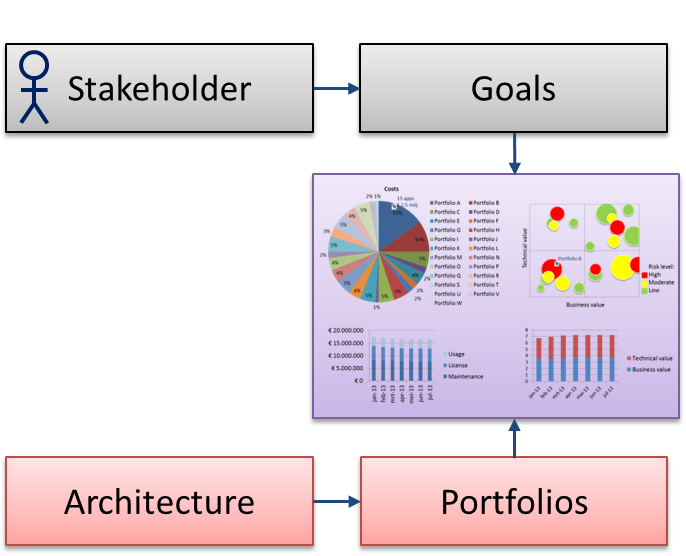For many organizations, the enterprise landscape is growing out of control. Simply keeping up with competition and evolving markets means that organizations constantly renew services offered to customers. These new services are supported by new processes, applications and infrastructure that are added to the landscape, making it larger and more complex.
Other organizations are confronted with mergers, leading to information systems that have duplicate functionality. They lack an overview of the ever-growing application landscape and, therefore, have no proper basis for making well-informed decisions.
To gain control over these large landscapes, it is necessary to move away from the occasional must rationalization effort and the ad hoc manner of managing these landscapes. Therefore, organizations look for a way to implement a continuous process for evaluating the landscape against business-relevant criteria, deciding on investment priorities based on this evaluation, and acting upon these decisions. Many organizations choose to gather, for example, applications and projects into portfolios. Portfolio managers gain a better overview of the landscape and can manage it as a group, instead of having to manage each application and project by itself. A budget can be allocated at the more strategic portfolio level, avoiding detailed discussions by upper-level management on many small initiatives.
Enterprise Portfolio Management (EPM) is an integrated portfolio management approach that tightly manages strategic planning against the various portfolios of interdependent assets, like product portfolios and project portfolios.
There is a difference between managing the things you have (assets) and the things you want (changes). An asset portfolio can consist, for example, of services, products, applications or servers. Managing such a portfolio means that you consider which assets you want to acquire, keep, change, replace or phase out. Based on these decisions, change initiatives are formulated to realize the changes. These initiatives can take the form of the familiar programs and projects, but increasingly we see organizations moving towards a way of working based on value streams and continuous delivery. Our EPM approach applies to these as well.
These initiatives, in turn, are managed in portfolios where decisions on resource allocation, investments, and planning are made. Detailed roadmaps show, for example, which product can be launched at what moment. Periodically, both the asset and change portfolios are assessed and readjusted based on their performance and changing business priorities.

Enterprise architecture provides an abundance of information on your organization. Using this as a basis for portfolio management will bring an enterprise wide-view of the landscape while connecting it to different disciplines such as strategic management.
Defining meaningful portfolios is a prerequisite for successful portfolio management. Decisions on, for example, which products, projects or applications are managed in one portfolio define the success or failure of EPM for your organization. The enterprise architecture assists in this discussion by providing the interdependencies between the different elements of a portfolio and their context. For example, an application portfolio might hold applications related to a certain channel (e.g. the Internet domain), a specific business process or function (e.g. Sales), a specific stakeholder group, a technology stack, or any other coherent grouping deemed relevant from a business perspective.
Another important reason to use the enterprise architecture is the enterprise-wide view it provides. Relating portfolios to the organizational strategy is a goal many CxOs have. Aligning the different disciplines ensures coherent and effective management on a strategic, business and technical level.
You can use your enterprise architecture to compare different views of the organization, for example, to conduct an impact analysis or do a cost calculation for different investment alternatives, since these views are based on the same underlying model. To illustrate this, consider the following example: A software vendor offers a monitoring application to its customers. Its basic functionality is monitoring the performance of other applications such as websites. It is, however, possible to purchase additional functionality that allows programming robots for performing composite monitoring. This enables monitoring whether, for example, login functionality of a website is working properly. The application portfolio manager sees this as one application, which should be managed as a whole. However, the project portfolio manager considers the implementation of this as two distinct projects. For application and project portfolio managers to integrate their management decisions, they need to have a consistent view on the application landscape. Using enterprise architecture as an agreed-upon underlying model ensures consistent and, therefore comparable, views across disciplines.
So far, we discussed which ingredients are needed to make portfolio management a success, but accomplishing this is no sinecure. It is highly important to conduct a thorough design phase, in which stakeholders and their goals and concerns are identified, portfolios are defined that are aligned with these goals, and a valuation model is designed that addresses the concerns of these stakeholders. In other words, it is important to think about what you want to manage and for whom you are doing this for.
The stakeholder concerns are then addressed in dashboards that visualize portfolio scores of the applicable metrics in an intuitive manner. Dashboards are a powerful way of addressing such concerns in a direct way. An effective dashboard shows the relevant information in a clear, intuitive and understandable manner.

After designing your EPM approach, you can operationalize your plans and inventory the assets and change initiatives, analyze the value they have and make (investment) decisions using the designed dashboards.
In this blog, we have illustrated what EPM can do for your organization. EPM creates an enterprise-wide view of your organization that takes all of its levels, from strategy to infrastructure, into account. In this way, investment decisions contribute to the strategy of the enterprise. Check out Enterprise Portfolio Management: Deciding on Investments for more information about decision-making and investments using EPM.